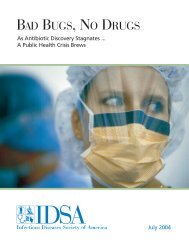Community-Based Surveillance of Antimicrobial Use and ...
Community-Based Surveillance of Antimicrobial Use and ...
Community-Based Surveillance of Antimicrobial Use and ...
- No tags were found...
You also want an ePaper? Increase the reach of your titles
YUMPU automatically turns print PDFs into web optimized ePapers that Google loves.
<strong>Community</strong>-based surveillance <strong>of</strong> antimicrobial use<strong>and</strong> resistance in resource-constrained settingsTable 7.1: Percentage <strong>of</strong> AMR in E. coli isolated from four centres10075% resistance50250Ampi Cotrim Ceph Genta Tetra Nal Cipro NitfurDelhi Pathogen Delhi Commensal Mumbai Vellore Pathogen Vellore Commensal BritsAMR rates among E. coli were high at all sites. At all sites, somewhat higher AMR rates wereobserved towards cotrimoxazole, ampicillin, tetracyclines <strong>and</strong> nalidixic acid, antibioticshistorically in longer use <strong>and</strong> AMR rates to these ABMs were lower among commensalbacteria than among pathogens. Resistance to fluoroquinolones <strong>and</strong> third‐generationcephalosporins was present in all areas, although the rates seemed to be much higher inIndia, especially among pathogens.Although the detection <strong>of</strong> trends over time was not a primary objective in the pilot projects,it was noted that no significant monthly variations in resistance rates during the period <strong>of</strong>study were seen. However, it must also be noted that the monthly numbers <strong>of</strong> isolates were<strong>of</strong>ten inadequate. There were also inadequate data to reliably underst<strong>and</strong> any differencesthat might have been present between locations <strong>and</strong> between facilities within a site. Ingeneral, where AMR rates among commensals <strong>and</strong> pathogens were studied separately, theAMR rates were lower among commensals.There are very few reports on AMR rates among commensal E. coli <strong>and</strong> those causingcommunity‐acquired UTI, collected systematically over a period <strong>of</strong> time from developingcountries. Data on the susceptibility <strong>of</strong> E. coli isolated from clinical samples submitted forroutine examination have been reported from two large international data sets (SENTRY <strong>and</strong>MYSTIC) 33 . These revealed definite geographical differences, as summarized in Table 7.2.Non‐susceptibility rates were generally higher in South Africa <strong>and</strong> Asia as compared tocountries such as the USA <strong>and</strong> Canada during the period 1997‐2001.80




